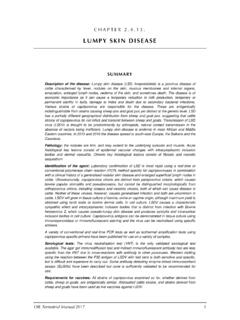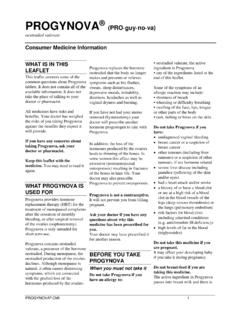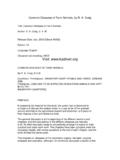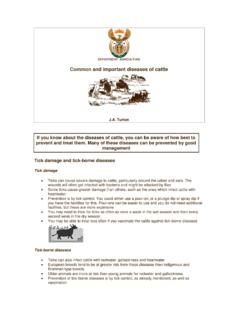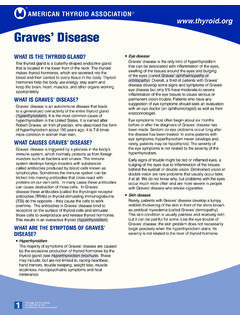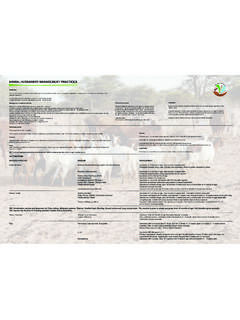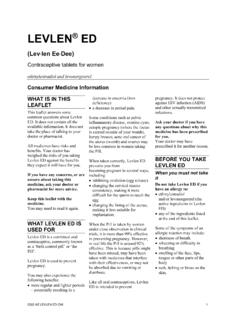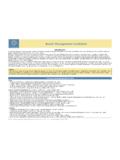Transcription of Classification of the causative agent Resistance to ...
1 1 lumpy skin disease Aetiology Epidemiology Diagnosis Prevention and Control References AETIOLOGY Classification of the causative agent lumpy skin disease (LSD) is caused by lumpy skin disease virus (LSDV), a virus from the family Poxviridae, genus Capripoxvirus. Sheeppox virus and Goatpox virus are the two other virus species in this genus. Resistance to physical and chemical action Temperature: Susceptible to 55 C/2 hours, 65 C/30 minutes. Can be recovered from skin nodules kept at 80 C for 10 years and infected tissue culture fluid stored at 4 C for 6 months. pH: Susceptible to alkaline or acid pH. No significant reduction in titre when held at pH for 5 days at 37 C. Chemicals/Disinfectants: Susceptible to ether (20%), chloroform, formalin (1%), and some detergents, sodium dodecyl sulphate. Susceptible to phenol (2%/15 minutes), sodium hypochlorite (2 3%), iodine compounds (1:33 dilution), Virkon (2%), quarternary ammonium compounds ( ).
2 Survival: LSDV is remarkably stable, surviving for long periods at ambient temperature, especially in dried scabs. LSDV is very resistant to inactivation, surviving in necrotic skin nodules for up to 33 days or longer, desiccated crusts for up to 35 days, and at least 18 days in air-dried hides. It can remain viable for long periods in the environment. The virus is susceptible to sunlight and detergents containing lipid solvents, but in dark environmental conditions, such as contaminated animal sheds, it can persist for many months. EPIDEMIOLOGY Morbidity rate varies between 10 and 20%. Mortality rates of 1 to 5% are considered usual. Hosts LSDV is highly host specific and causes diseases only in cattle (Bos indicus and B. taurus) and water buffalo (Bubalus bubalis). There is evidence from a study in Ethiopia of differential breed susceptibility to LSD, with Holstein Friesian or crossbred cattle exhibiting higher morbidity and mortality due to LSD when compared with local zebu cattle Extensive serological surveys of wild ruminant species in Africa have not identified a wildlife reservoir of LSDV.
3 The virus appears to be highly host specific. LSDV is not zoonotic. Transmission The principal means of transmission is believed to be by arthropod vector. Though no specific vector has been identified to date, mosquitoes ( Culex mirificens and Aedes natrionus), biting flies ( Stomoxys calcitrans and Biomyia fasciata) and male ticks (Riphicephalus appendiculatus and Amblyomma hebraeum) could play a role in the transmission of the virus. The importance of different 2 arthropod vectors is likely to vary in different areas depending on the abundance and feeding behaviour of the vector. Infected bulls can excrete the virus in the semen, however transmission of LSD via infected semen has not been demonstrated. It is not known if transmission can occur via fomites, for example ingestion of feed and water contaminated with infected saliva. Animals can be infected experimentally by inoculation with material from cutaneous nodules or blood.
4 Direct contact is considered to play a minor, if any, role in the transmission of the virus. Sources of virus skin nodules, scabs and crusts contain relatively high amounts of LSDV. Virus can be isolated from this material for up to 35 days and likely for longer. LSDV can be isolated from blood, saliva, ocular and nasal discharge, and semen. LSDV is found in the blood (viraemia) intermittently from approximately 7 to 21 days post-infection at lower levels than present in skin nodules Shedding in semen may be prolonged; LSDV has been isolated from the semen of an experimentally infected bull 42 days post-inoculation. There has been one reported of placental transmission of LSD. LSD does not cause chronic disease . It does not exhibit latency and recrudescence of disease does not occur. Occurrence LSD is endemic in most African countries. Since 2012 it has spread rapidly through the Middle East, south-east Europe, the Balkans, Caucasus, Russia and Kazakhstan.
5 For more recent, detailed information on the occurrence of this disease worldwide, see the OIE World Animal Health Information Database (WAHID) Interface [ ] DIAGNOSIS Under experimental conditions, following the virus inoculation, the incubation period is between 4 and 14 days. For the Terrestrial Manual purposes, the incubation period is 28 days. Clinical diagnosis LSD signs range from inapparent to severe disease . There is no current evidence of variation in virulence regarding the different LSDV strains. Fever that may exceed 41 C. Marked reduction in milk yield in lactating cattle. Depression, anorexia and emaciation. Rhinitis, conjunctivitis and excessive salivation. Enlarged superficial lymph nodes Cutaneous nodules of 2 5 cm in diameter develop, particularly on the head, neck, limbs, udder, genitalia and perineum within 48 hours of onset of the febrile reaction.
6 These nodules are circumscribed, firm, round and raised, and involve the skin , subcutaneous tissue and sometimes even the underlying muscles. Large nodules may become necrotic and eventually fibrotic and persist for several months ( sit-fasts ); the scars may remain indefinitely. Small nodules may resolve spontaneously without consequences. Myiasis of the nodules may occur Vesicles, erosions and ulcers may develop in the mucous membranes of the mouth and alimentary tract and in the trachea and lungs. Limbs and other ventral parts of the body, such as the dewlap, brisket, scrotum and vulva, may be oedematous, causing the animal to be reluctant to move. Bulls may become permanently or temporarily infertile. Pregnant cows may abort and be in anoestrus for several months. 3 Recovery from severe infection is slow due to emaciation, secondary pneumonia, mastitis, and necrotic skin plugs, which are subject to fly strike and shed leaving deep holes in the hide.
7 Differential diagnosis Severe LSD is highly characteristic, but milder forms can be confused with the following: Bovine herpes mammillitis (bovine herpesvirus 2) (sometimes known as pseudo- lumpy skin disease ) Bovine papular stomatitis (Parapoxvirus) Pseudocowpox (Parapoxvirus) Vaccinia virus and Cowpox virus (Orthopoxviruses) uncommon and not generalised infections Dermatophilosis Demodicosis Insect or tick bites Besnoitiosis Rinderpest Hypoderma bovis infection Photosensitisation Urticaria Cutaneous tuberculosis Onchocercosis Laboratory diagnosis Samples Identification of the agent Polymerase chain reaction (PCR) is the least expensive and quickest method for detection of LSDV. skin nodules and scabs, saliva, nasal secretions, and blood are suitable samples for PCR detection of LSDV. Virus isolation (VI) followed by PCR to confirm the virus identity takes longer and is more expensive but has the advantage of demonstrating the presence of live virus in the sample.
8 Electron microscopy can be used to identify the classic poxvirus virion but cannot differentiate to genus or species level. Serological tests It is not possible to distinguish the three viruses in the Capripoxvirus genus (Sheeppox virus, Goatpox virus and LSD) using serological techniques. Virus neutralisation: this is currently the gold standard test for the detection of antibodies raised against capripoxviruses. Western blot: highly sensitive and specific but expensive and difficult to perform. Capripoxvirus antibody enzyme-linked immunosorbent assay: new commercial kits for detection of capripoxvirus antibodies are currently being developed and released on to the market. For more detailed information regarding laboratory diagnostic methodologies, please refer to Chapter lumpy skin disease in the latest edition of the OIE Manual of Diagnostic Tests and Vaccines for Terrestrial Animals under the heading B.
9 Diagnostic Techniques . PREVENTION AND CONTROL Evidence from the current LSD epidemic in Europe and western Asia has revealed that successful control and eradication of LSD relies on early detection of the index case, followed by a rapid and widespread vaccination campaign. The efficacy of total stamping-out (killing all clinically affected cattle and unaffected herd-mates) and partial stamping-out (killing only clinically affected cattle) policies have been compared using mathematical modelling. The study found that total stamping-out and partial stamping-out resulted in 4 a similar probability of eradicating the infection. The study also highlighted the importance of initiating vaccination campaigns ahead of virus entry. Sanitary prophylaxis Free countries: o Import restrictions on domestic cattle and water buffaloes, and selected products from these animals.
10 O Surveillance measures to detect LSD are recommended over a distance of at least 20 kilometres from an infected country or zone Infected countries: o Control of LSD depends on restriction of movement of cattle in infected regions, removal of clinically affected animals, and vaccination. Movement restrictions and removal of affected animals alone without vaccination are usually not effective. o Proper disposal of dead animals ( incineration), and cleaning and disinfection of premises and implements are recommended for LSD. o There is currently no evidence of the efficacy of vector control in preventing disease o See OIE Terrestrial Animal Health Code for regulations covering the recovery of LSD-free status of a country or zone. Medical prophylaxis Homologous LSDV live attenuated vaccine strain for example Neethling LSD strain Heterologous sheeppox or goatpox virus live attenuated vaccine strain.










